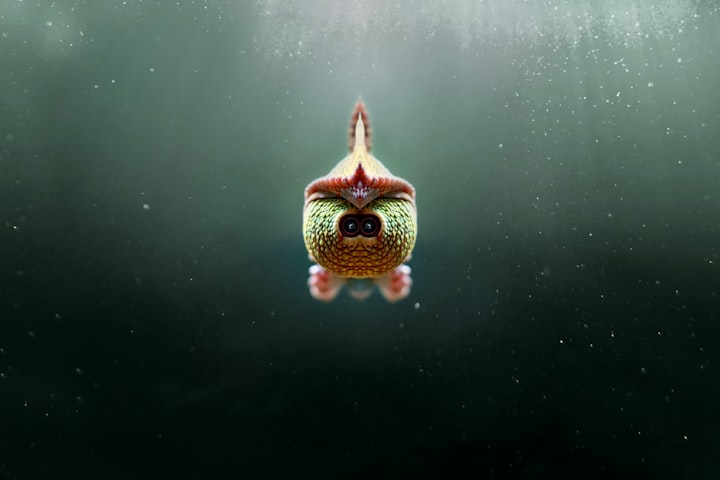Divers Are FREAKING Out Over These Deep Sea Creatures...
Deep sea creatures

The ocean is an incredibly captivating place, and it has always piqued our curiosity, especially when it comes to uncovering the mysteries that lie beneath its depths. Deep-sea creatures are truly extraordinary, unlike any everyday fish or creatures we are familiar with. They inhabit one of the most inhospitable environments on Earth. After a recent scuba diving expedition, it only makes sense for us to revisit this timeless fascination. So, without any further delay, let's illuminate the darkness and embark on an underwater journey. In 2019, renowned scientist Dr. Alan Jameson took a remarkable plunge into the Java Trench, descending a staggering 7,180 meters. This historic feat made him the first British person to achieve such a feat. Dr. Jameson was part of the "Five Deeps" expedition, led by the pioneering deep-sea explorer Victor Veso.
Equipped with a specially designed deep submergence vehicle called the Limiting Factor, the team aimed to reach the deepest point in each of the five oceans: the Puerto Rico Trench in the Atlantic, the South Sandwich Trench in the Southern Ocean, the Challenger Deep in the Pacific, the Malloy Deep in the Arctic, and the Java Trench in the Indian Ocean. It was during their descent to a depth of 4.5 meters in the Java Trench that something extraordinary happened. The crew stumbled upon a previously unseen creature in the trench. This unique gelatinous animal is believed to be a new species of stalked aidian or SE squirt, resembling a balloon attached to a string. Its ghostly silhouette drifts through the unfamiliar underwater landscape, leaving the crew of the five deeps in awe. Little is known about how it survives 2396 ft below the surface of the Indian Ocean. While it is thought to be anchored to the seabed by its tentacle, it has raised its body from the bottom on this occasion, possibly to filter food from the water.
Research later revealed that a group in Japan had described a similar creature about 20 years ago, but key differences exist between the two. With the newly found creature lacking filaments on top of its head, there is a high probability that it is a new species. Given that the deepest parts of four out of the five oceans remain unexplored by humans, it is not surprising that there are potentially numerous undiscovered species. This rare footage may not be captured again for a hundred years or more. This particular fish, known as the ogre fish or fang tooth, is a creature that can be found worldwide in the icy ocean depths, reaching depths of up to 5,000 meters. It is considered one of the deepest living creatures in the sea. Despite its terrifying appearance, what stands out the most about this fish is its teeth. In relation to its size, the fang tooth has the largest teeth of any other fish.
The most notable features are the two long fangs on its lower jaw, which are so long that they have evolved specialized sockets on each side of their brain to aid in closing their mouths, although they are unable to fully close them. With a total of 14 enormous fangs, making up a third of its body, this creature has rows of tiny teeth inside its mouth that help grasp onto smaller prey. The fang tooth's teeth are laterally flexible, allowing it to consume food items of various sizes. There are two species of fang tooth: the common fang tooth and the short horn fang tooth, both of which are relatively small, reaching around 18 cm.
Otherwise, with their teeth, they would be formidable predators. Little is known about these creatures, and the short horn fang tooth has only been observed in infancy, so its full size remains a mystery. Despite their small size, they possess a powerful bite and can swiftly devour their prey, as shown in the captivating documentary footage from BBC's Blue Planet 2, which depicts the fang tooth's savage attack on a helpless victim. t is important to note that the footage was captured in a container on board a ship, and no such attack has ever been recorded in the creature's natural habitat.
Therefore, much of the behavior of these fish must be left to the imagination. Unlike many other deep-sea creatures that lose their form and function when brought to the surface, the fangtooth fish is incredibly robust. It has been observed that the fangtooth can survive brief periods of time at surface pressure in a lab setting, with no impact on its ability to breathe. The lateral line organ in the fang tooth is highly developed, acting as a sort of sixth sense to detect motion and pressure changes. This organ consists of a row of cellular hairs that send signals in response to changes in motion. While this feature is found in many fishes, it is exceptionally well-developed in the fang tooth, possibly to compensate for its poor eyesight. There is still much to discover about these deep-sea mysteries, and due to the hostile environment they inhabit, we may never fully understand how they live, breed, or how large they can grow. It is a chilling thought that if they were to reach enormous sizes, their formidable teeth could potentially make them formidable predators, even capable of taking on creatures as large as humans. The bobbit worm, also known as the sand striker, is a creature that inspires fear and awe.
This ferocious predator burrows into the sand and patiently waits for unsuspecting prey, resembling something out of a science fiction horror film. Bobbit worms can be found at the bottom of tropical and subtropical bodies of water in various regions such as Bali, New Guinea, the Philippines, Australia, Fiji, and Indonesia. While the average length of a bobbit worm is around 3 feet, there have been rare instances of them growing as large as 10 feet. Remarkably, these creatures are believed to have existed for at least 20 million years, as evidenced by fossilized remains found in Taiwan. Bobbit worms construct burrows in the sand using a special mucus to reinforce the walls of their homes. If that wasn't unfortunate enough, the Venom-laced spines possess enough power to incapacitate a human, making the bobbit worm one of the most weaponized fish out there. One redeeming quality is that this peculiar-looking creature is nearly blind and, similar to the ogrefish, uses its antenna to detect prey. Bobbit worms belong to the class Polychaeta, which means "many hairs" in Greek.
Their lengthy bodies are covered in tiny bristles that aid in propelling them out of their burrows and securing them in place when hiding. Additionally, they have the ability to split into multiple parts when feeling threatened or reproducing asexually, a phenomenon known as "multiplying." Despite these characteristics, the mucus secreted by the bobbit worm is rich in nutrients that sea microbes feed on.
Interestingly, the official name for a bobbit worm is Eunice Aphrodite’s. So, why is it commonly referred to as a bobbit worm? The answer lies in a fascinating backstory - they are named after Lorena Bobbitt, who gained notoriety for severing her husband's penis.
About the Creator
Nameless writer
"A weaver of words, crafting tales that dance on the edge of reality, inviting readers to lose themselves in the symphony of imagination"






Comments (1)
Deep sea creatures are grotesque